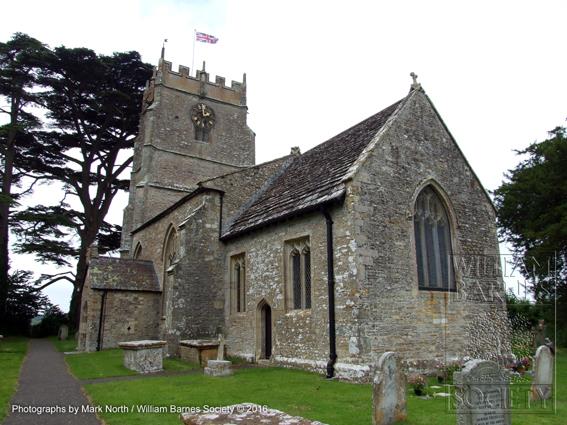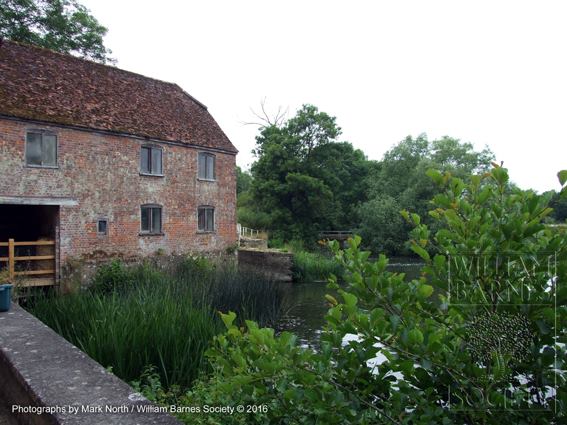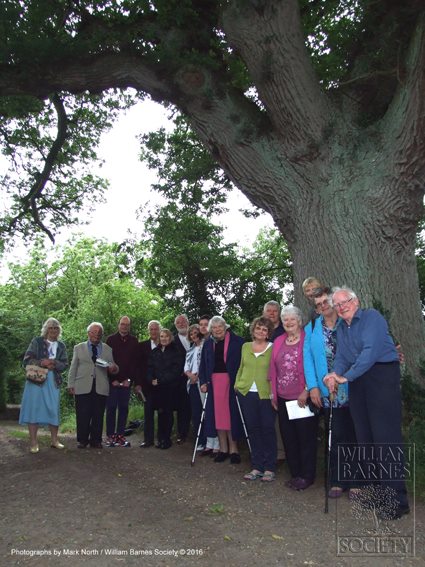A visit to Barnes' Blackmore Vale
By Marion Tait
One of the highlights of the Society’s Programme was the trip to the Blackmore Vale. A group of 25 Society members met at the Parish church of St Thomas A Beckett, Lydlinch, on a warm sunny afternoon on 9th July 2016.
Lydlinch is a village about 3 miles west of Sturminster Newton in the Blackmore Vale in North Dorset. The parish includes the village of King's Stag to the south and the hamlet of Stock Gaylard to the west. It is bounded by the Lydden to the east and its tributary the Caundle Brook to the north.

We were met by the church warden Mr Barratt who kindly gave us an informative talk on the church. The earliest Rector was Henry Haddon who was instituted in 1303. The church has a 12th-century font which is carved from a solid block of stone. The present building which is Perpendicular in style was erected in 1479 and the addition of the South Porch dated from the first major restoration in 1753. In the 19th century the north aisle was rebuilt and the north vestry added, the building being twice restored. The Hooper family gave a new stained glass window which was fitted to the east window over the Alter; no relation to Keith Hooper who is a society member
There are three sundials in the church, one is over the Porch, and one each on the North and West corners of the Tower. The Tower was refurbished in 1959 when new clock faces were also fitted. The five bells were also rehung the same year.
An interesting fact is that in the church porch there are scratch marks and graffiti known as ‘apotropaic symbols’. They were used to protect the building from harm of evil spirits and witches curses. Most that have been found elsewhere in Britain, date from the 16th to the 18th centuries.
The beautiful church of St Thomas A Beckett is set in picturesque surroundings. It is a Grade 11 listed building and well worth a visit. William Barnes was born just outside the parish in nearby Bagber and wrote ‘Lydlinch Bells’ in the Dorset dialect.
"Still Lydlinch bells wer good vor sound, An’ liked by all the naighbours round".
After the much appreciated talk by Mr Barratt we were treated to the poem ‘Lydlinch Bells’ read beautifully by Charles Buckler, Brian Caddy, Keith Hooper, Brian Button and Rod Drew. This was then followed by Brian reading “The Church An’ Happy Zundayâ€. A perfect end to the first stop of our summer outing.

Onward to Sturminster Newton Mill, our second stop, where we were met by Peter Loosmore the Mill Supervisor. Peter was very knowledgeable and started the tour by giving us an in-depth history of the mill. The mill was built on the river Stour, over one thousand years ago. There were originally two mills, one a fulling mill, the other a grist mill with separate mill wheels sharing a common pit in the centre.
The present L shaped building consists of the South and North wings. The South wing sits on the river bank and was rebuilt in 1650. The North wing which juts into the river was originally a completely separate fulling mill.
The fulling mill involved the cleansing of newly woven woollen cloth to eliminate oils, dirt and other impurities and in turn make the wool thicker. This cloth became known locally as Swanskin. This cloth was produced for over 200 years. In 1904 the two wheels were replaced by the single Arrmfield turbine which still operates to this day. There was evidence of Daisy Wheel Scratch Marks in the mill doorway which were used to trap evil spirits. These marks often applied to entry points in a building and dated back as far as the 16th century.
The demonstration of the complete working process covered three floors which was fascinating. We learned how the grain was fed down into the millstones from the upper story resulting to the flour being collected into the sacks, then weighed and packed into bags ready to sell in the shop. There was a new display centred on the fulling mill, the fulling process and the strong links with Newfoundland where much of the Swanskin was exported for use by the cod fishing industry.
Between the months of October and March is a busy time at the mill with maintenance being carried out and repair of the machinery. During this period all equipment on the ground floor is stored on the first floor just in case there is a flood. The deepest flood was in 1756 when the water rose to 5 foot above floor level. The latest flood was in 2013 when the water rose to four foot four inches above floor level.
Once more we were treated to a wonderful dialect reading by Charles Buckler and Brian Caddy-’John Bloom In Lon’don’
"John Bloom he wer a jolly soul, A grinder o’ the best o’meal."
In the 1990’s, due to the food hygiene, health and safety regulations the mill faced closure. It was then taken over by the Sturminster Newton Museum Society, and is now run as a visitor attraction.
The visit to the Mill had been very enjoyable and informative tour and many of us carried bags of flour back to the car with the promise of baking some rolls. Sturminster Mill is well worth a visit, a must for the diary
From here we drove through the beautiful, peaceful hamlet of Bagber where William Barnes was born at Rushay not far from Pentridge. We continued to the Manor House. a splendid looking Victorian house set in idyllic grounds with chickens and ducks in the driveways. The stone pillars, low stone walls and stable blocks survived from when the house was rebuilt along with the Shirley family coat of arms dated 1599 which also adorned the front of the house which William Barnes was so fond.
We walked up the drive and under the lilac flower and rose arch to the front of the house. There were daisies growing on the terrace outside the front door while swallows were breeding in the porch.
Our hosts James and Tamsin Holroyd welcomed us to their home and we were led to the kitchen area for refreshments. The table was laden with delicious triangular sandwiches, cake, home-made scones, jam and cream not forgetting priceless cups of tea. It was so very kind of Tamsin and James to invite us into their home and provide such an excellent spread. Tamsin was presented with a bouquet of flowers and a subscription to the William Barnes Society for a year.
After tea we were entertained again to some of Barnes’ dialect poetry including:

‘A Ghost,’ ‘Shirley’s House,’ (John Shirley a magistrate once lived in the house) ‘Easter Zunday,’ ‘The Carter,’ ‘The Girt Woak Tree That’s in the Dell,' and ‘Evenen in the Village,’ read by Brian, Charles, Rod, Ann and Keith.
Brian and Charles read the Eclogue: ‘A Ghost’ which was so surreal being in The Manor House which Barnes referred to as ‘The Haunted House’.
It was the ghostly stories from Barnes’s grandfather’s encounters along the halter path, the haunting of the Manor House and a spectral Black Dog that inspired Barnes to write ‘A Ghost’.
After listening to Barnes’s poems a group of members decided to put their best foot forward, the need to experience the special Girt Woak Tree for themselves.
‘Aye, up that lane for one short mile I went, at evening, time on time,’ ‘Shirley Hall,’ is the inviting Halter path leading to Barnes’ Oak.
The path runs from The Manor House to Sturminster, and is an enchanting walk of trees and fields: the cattle were grazing and horses playing in the fields. ‘The Girt Woak’ was recited a second time and the magical feeling returned. To stand on the spot and touch the tree that Barnes so loved and see opposite the site of ‘Golden Gate,’ the house where Barnes and family had lived was incredible.
The history of Barnes’s childhood came to life and how privileged I for one felt
It had been a wonderful visit to the Blackmore Vale, a day I think we will never forget.
Â
More news









Starts 00:00
William Barnes Harvest Celebration

19:00 till 22:00
The Year Clock

10:45 till 15:00
William Barnes and Thomas Hardy Study Day

15:00 till 17:00
The Year Clock

14:30 till 15:30
Keepen Up O' Chris'mas

Starts 09:00
Barnes Night: A Celebration of the Life and Work of William Barnes

